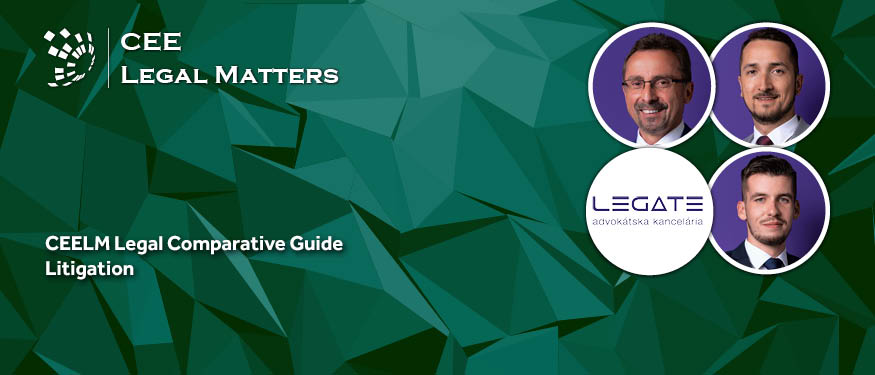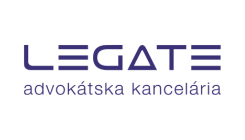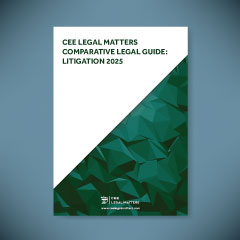Contributed by Legate.
1. General Trends
1.1. What is the current state of litigation in your jurisdiction, and what recent trends or developments have been observed?
Slovak courts are still battling with several internal issues such as personnel shortage (mostly court officers and judge assistants), electronic processing of procedures, and specialization of courts on specific agendas causing strenuous and long decision-making processes.
However, since June 1, 2023, judicial map reform came into effect, and one of the main aims of the new judicial map is to specialize judges for specific agendas on a regional level such as commercial law, civil law, family law, criminal law, and administrative law matters in the separate administrative justice system.
It is expected that the new judicial map could provide more precise and faster decision-making results with improved quality of court decisions.
One of the most important effects of the judicial reorganization in Slovakia was also to:
• increase the level of transparency of the procedures, which comes in conjunction with e-court management and access of citizens and judiciary governing bodies to have a better overview and access to resolve disputes. Transparency definitely contributes to increasing of the credibility of the judiciary power;
• increase effectiveness which secures specialized judges in fewer courts that will ensure efficient handling of cases in respective agendas (different from the current set-up where delays in court proceedings often occur).
1.2. What are the key legal frameworks that regulate litigation?
The Slovak legal system is governed by the following key civil court litigation frameworks:
• Act No. 160/2015 Coll. the Code of Contentious Civil Procedure aimed at civil and commercial litigation;
• Act No. 161/2015 Coll. the Code of Non-Contentious Civil Procedure aimed at non-contentious agendas such as family law, corporate registry procedures, or inheritance procedures;
• Act No 162/2015, the Code of Administrative Procedure aimed at the review of decisions adopted within the administrative decision-making process.
2. Jurisdiction and Competence
2.1. How is the court system structured in your jurisdiction?
The judicial power is being performed by civil (state) courts and the Constitutional Court of the Slovak Republic.
The judicial structure of civil courts includes:
• 36 district or municipal (per region of Bratislava and Kosice) courts – mostly acting as the first-level civil courts;
• 8 regional courts – mostly acting as the appeal civil courts;
• Supreme Court of the Slovak Republic.
On June 1, 2023, judicial map reform came into effect that significantly changed the number of civil courts (originally there were 54 district courts) to reach its goals with an emphasis on functional specialization of the judges on first instance courts including the quality improvement of decision-making standards.
District courts in Bratislava and Kosice have been consolidated into municipal courts (there will be four municipal courts in Bratislava instead of five district courts and one municipal court in Kosice instead of three district courts).
Local jurisdiction also includes the Supreme Administrative Court of the Slovak Republic authorized to resolve complex administrative disputes on the top level and the Specialized Criminal Court of the Slovak Republic dealing with the most complex and high-profile criminal cases within the Slovak jurisdiction.
2.2. Are there specialized courts for specific types of litigation?
Act No. 160/2015 Coll. the Code of Contentious Civil Procedure diversifies the causal jurisdiction of courts to specific litigations, e. g. commercial disputes, employment disputes, intellectual property rights disputes, or competition law disputes.
2.3. How is jurisdiction determined in cross-border litigation, especially in cases involving foreign parties or multiple jurisdictions?
The basic legal act that determines which court is authorized to resolve the dispute with a foreign aspect is Act No. 97/1963 Coll. on private and procedural international law. The provisions of this act apply only if the directly applicable laws of the European Union or an international agreement by which the Slovak Republic is bound do not stipulate otherwise.
The authorization of the state courts to resolve the dispute between the parties is being assessed by the court ex-officio at any stage of the dispute.
Regulation No. 1215/2012 of the European Parliament and the Council on jurisdiction and the recognition and enforcement in civil and commercial matters fully applies to local jurisdiction which determines the authorization of Slovak court to resolve the dispute if the dispute is between the parties from EU member states.
3. Initiating Litigation
3.1. What are the primary steps required to initiate litigation in your jurisdiction?
The proceedings are commenced upon filing the motion to the court by the plaintiff.
After the plaintiff pays the court fee, the court shall deliver the motion to the defendant with a request for a statement of defense.
All motions and statements made by parties are delivered to the counterparties via court either electronically or by post if such party does not dispose of the databox (only legal entities are obliged to activate the databox).
If the party is represented by an attorney, all communication is delivered through such attorney (data-box is mandatory for attorneys).
3.2. Are there any specific requirements for parties regarding pre-litigation procedures?
Mostly, no pre-action conduct is required to initiate the dispute before an authorized court.
In specific cases, pre-action conducts are required if parties pre-agreed to such conduct before the dispute such as dispute adjudication board (DAB) clauses which are common in commercial litigations.
Local jurisdiction puts pre-action conduct requirements only with respect to disputes raised against the consumers. In case of non-observance of the pre-action conduct, the plaintiff is at high risk of procedural failure – the court may dismiss the lawsuit.
4. Timelines
4.1. What are the typical timelines for different stages of litigation, from initiation to resolution?
The standard structure of procedural motions to be produced by the parties are:
• plaintiff’s action (lawsuit or statement of claim);
• defendant’s response (statement of defense);
• plaintiff’s rebuttal;
• defendant’s rejoinder.
The court ordinarily grants 10 to 15 days to the party to produce the respective response.
There are no limitations on further motions, however, the authorized court resolving the dispute will deliver further motions to the counterparty to take note of such motion without requesting another counter-motion.
4.2. Are there specific time limits for filing claims, and do these vary depending on the type of dispute?
The basic limit for filing a lawsuit is the running of the statute of limitations.
The court shall only take into consideration the statute of limitations on the debtor’s objection. If the debtor invokes the statute of limitations, the creditor may not be granted the time-barred right.
A different statute of limitations is provided for certain special claims, e.g., compensation for damages or unjust enrichment. In general, the compensation for damage is time-barred two years from the date on which the injured party becomes aware of the damage and who is liable for it.
In case of a valid judgment or debtor’s acknowledgment, the statute of limitations of the creditor’s claim could be extended up to 10 years.
However, the general statute of limitations under the Slovak Civil Code is tjree years. In commercial disputes (B2B) general statute of limitations is four years.
5. Interim Measures
5.1. What interim remedies are available in your jurisdiction?
There are two main types of interim remedies (or injunctions): security measures and preliminary measures.
As a security measure, the court may establish a lien on the debtor’s property or rights to secure the creditor’s monetary claim if there is a fear that the enforcement of judgment can be endangered. Security measures have precedence over preliminary measures and can only be issued if the intended purpose cannot be achieved by a security measure.
The preliminary measure may be issued by the court provided the situation needs to be temporarily regulated without delay or if there is a fear that the execution of judgment can be endangered.
Provided the court issues a preliminary measure or security measure, its delivery to the defendant gains immediate enforceability. However, the defendant can appeal against the measure within 15 days. Moreover, the defendant may always apply for annulment of the measure in case the reasons for which the measure has been issued have ceased to exist.
5.2. Under what circumstances can a party obtain an interim injunction, and how quickly can such relief be granted?
The terms and conditions for the issuance of an interim remedy (or injunction) are set out in section 324 et seq. of Act No. 160/2015 Coll. the Code of Contentious Civil Procedure.
An interim remedy may be ordered by the court before, during, or after the proceedings, as the case may be.
The law provides for only two reasons for the application of this form of procedural measure, namely the need to adjust the circumstances without delay and the fear that the execution will be threatened.
The court shall, as a rule, decide based on documental content provided by the plaintiff even without hearing, giving a statement of the parties, evidence evaluation (such as it is in the regular procedure), and scheduling a hearing.
The court shall not take proper evidence and shall base its decision on the contents of the application and on the facts which have been proved in connection with the application.
The court shall decide within the statutory period of 30 days from the receipt of a complete motion, except in the case of domestic violence, which must be decided within 24 hours.
6. Discovery
6.1. What are the rules governing the discovery process in your jurisdiction?
Evidence production and evaluation in litigation proceedings is regulated in section 185 et seq. of Act No. 160/2015 Coll. the Code of Contentious Civil Procedure, as amended.
Evidence in litigation is strictly based on the procedural responsibility of the parties and limits the court’s activity in proposing and therefore conducting evidence. However, there are also obligations connected with the taking of evidence that the parties must fulfill before the court begins to take evidence, namely the obligation of the parties to argue and to propose evidence to prove their claims.
In order to make the evidence effective, the lawmaker proceeded to the concept of time-limited evidence production within the proceeding (concentration of proceedings). The purpose of the concentration of proceedings is to carry out certain procedural acts at a certain stage of the proceedings. The procedural responsibility of the parties and their active and responsible approach to the obligation to plead and the subsequent burden of proof come to the fore. The concentration of proceedings eliminates the negatives of the various procedural tactics of the parties and allows the court to complete the factual and evidentiary material within a certain period of time.
Due to the obligation to present timely means of procedural attack and defense, the court is to obtain as early as possible the basis for determining the subject matter of the evidence, with the possibility of future modification of the subject matter of the evidence being eliminated only for unavoidable and unforeseeable changes or for changes resulting from the results of the evidence taken.
Facts and evidence presented late shall not be considered by the court and shall therefore be treated as if they had not been adduced. The Court may not therefore use them to prove or disprove the parties’ arguments.
6.2. What types of evidence can be requested, and how are discovery disputes resolved?
Pursuant to section 187 subsection 2 of Act No. 160/2015 Coll. the Code of Contentious Civil Procedure, as amended, the standard means of proof are, in particular, the hearing of a party, the hearing of a witness, a document, an expert statement, expert evidence, and inspection.
If the manner of evidence production is not prescribed, the court shall determine it.
6.3. How is evidence presented and evaluated during litigation?
Pursuant to section 191 subsection 1 of Act No. 160/2015 Coll. the Code of Contentious Civil Procedure, as amended – the court shall assess the evidence according to its discretion, each piece of evidence individually, and all the evidence in its context. In doing so, it shall take careful account of everything that has come to light in the course of the proceedings.
This is the principle of the so-called free evaluation of evidence – no one piece of evidence has a prescribed higher “value” over another piece of evidence. The concept of free evaluation of evidence is considered fairer because it allows for more individualization of the court’s decision – for example, witness testimony or expert testimony does not have any prescribed legal force, “value”, thus allowing the judge to attribute probative force to this evidence for the purposes of a particular proceeding and not be bound by an absolute, unbreakable statutory injunction.
7. Enforcement of Judgments
7.1. What types of judgments can be issued in civil litigation, and how are they enforced?
As a rule, the court decides on the merits of the case by judgment – and on the contrary, if it decides by judgment, it always decides on the merits, on the merits of the case.
Provided that it is expedient to do so the court may by judgment first determine part or all of the cause or ground of action. Where the court decides only part of the matter before it, we speak of a partial judgment.
Partial judgment (section 213 of Act No. 160/2015 Coll. the Code of Contentious Civil Procedure, as amended) – if the lawsuit asserts multiple procedural claims or a single procedural claim that is the subject of severable relief, the law allows for a partial judgment to be entered on a partial claim.
The court may in specific cases (based on the type of dispute) decide on the merits of the pleaded cause of action – then we speak of a judgment on a legal basis. After the validity of such judgment on a legal basis, the court resolves on the amount of the claim.
Judgment on a legal basis (section 214 of Act No. 160/2015 Coll. the Code of Contentious Civil Procedure, as amended) – these are situations where an action for performance is brought, and in the context of that action the question arises whether there is a right from which the litigant derives an obligation to perform against the defendant. That determination is therefore preliminary to the procedural claim (performance of the obligation) originally asserted.
If a party of dispute is passive, the court may also issue a judgment by default.
Judgment by default (section 273 of Act No. 160/2015 Coll. the Code of Contentious Civil Procedure, as amended) – default judgment is the most severe procedural sanction that the law allows to be imposed. It has the effect of losing the case, with the effect of an obstacle to the resolution of the case (obstacle rei iudicatae), but without the court giving one of the parties the opportunity to present its factual claims and legal arguments – e.g., by failing to appear without excuse at the scheduled hearing.
Enforcement of judgments may occur by voluntary fulfillment of obligations by the obliged person or by filing a petition for enforcement – subsequent enforcement, if the obliged person does not voluntarily fulfill the obligation within the time limit set in the judgment.
7.2. Are there specific provisions for cross-border litigation or enforcement of foreign judgments?
In the conditions of the Slovak legal system, we distinguish several regimes of recognition of enforceability of a foreign decision, depending on the nature of the foreign judgment and whether it was issued in an EU member state or a third country.
If the foreign judgment was issued in an EU member state, it depends on whether it was issued by a general court or arbitration court. Foreign arbitration awards issued within the EU can be enforced under the Convention on the Recognition and Enforcement of Foreign Arbitral Awards (The New York Convention) from 1958. Judgment issued by a civil court in another member state shall be enforced under Regulation no. 805/2004 on the European Enforcement Order.
Provided foreign judgment was issued under the jurisdiction of a third country, a regime under a bilateral treaty or a regime under an international treaty is possible for the recognition of such judgment. The provided procedure under a bilateral or a multilateral international agreement shall not be possible, the court shall proceed in accordance with the provisions of Act no. 97/1963 Coll. on private and procedural international law.
Enforcing a foreign judgment in the Slovak Republic by a bailiff requires prior recognition of a foreign decision as enforceable in the territory of Slovakia. In general, the enforcement procedure of foreign judgment requires translation by a sworn translator to Slovak, confirmation of enforceability under the jurisdiction of the court that issued the judgment, and proof of delivery of such judgment to the obliged party.
8. Appeal
8.1. What is the appeals process, and what are the grounds for appeal in your jurisdiction?
The Code of Contentious Civil Procedure recognizes ordinary and extraordinary legal remedies. The difference between an ordinary and extraordinary appeal is whether it is filed against a decision that has not yet entered into force, or against a final decision.
The appeal is filed with the court of first instance and not with the court of appeal, which will decide on the appeal.
The ordinary remedy is currently an appeal. The admissibility of an appeal is tied to three facts:
• an appeal is only admissible against a decision of the court of first instance, never against a decision of the court of second instance;
• admissibility of appeal in relation to the form of the decision (e.g., in the case of a payment order, the remedy is opposition);
• the need to challenge the operative part of the decision.
Pursuant to section 365 subsection 1 of Act No. 160/2015 Coll. the Code of Contentious Civil Procedure as amended, the appeal can only be justified by the fact that:
• procedural conditions were not met;
• the court, through incorrect procedural procedures, prevented a party from exercising its procedural rights to such an extent that the right to a fair trial was violated;
• the decision was made by a disqualified judge or an incorrectly constituted court;
• the proceedings have another defect that could have resulted in an incorrect decision in the matter;
• the court of first instance did not conduct the proposed evidence necessary to establish the decisive facts;
• the court of first instance reached incorrect findings of fact based on the evidence presented;
• the established facts do not stand because other means of procedural defense or other means of procedural attack are admissible and have not been applied; or
• the decision of the court of first instance is based on an incorrect legal assessment of the case.
The extraordinary remedies are re-trail, appellate review, and extraordinary appellate review by the general prosecutor of the Slovak Republic.
9. Costs and Funding:
9.1. How are legal costs determined, and what are the common practices regarding funding litigation?
Slovak legislation provides the instruments for litigation cost recovery.
With respect to recovery, we can identify the following principles determining the extent of the recovery such as:
• principle of success – the successful party shall request the recovery of the litigation costs (such as court fees, representation costs, and other necessary costs inducted by the dispute);
• principle of cause – the party which caused the costs shall bear them in full;
• fairness principle – the court may decide on no recovery in case there are exceptional circumstances causing the gross disparity between the parties.
9.2. Are there alternative funding options available for parties involved in litigation?
The National Parliament of the Slovak Republic adopted new (EU-based) legislation Act No. 261/2023 on collective protection of consumers’ interest as amended (the “Class Action Act”) which provides two types of collective redress mechanisms that also regulates litigation funding.
Class Action Act provides legal grounds for class action funding by an authorized person which is subject to registration before the Ministry of Economy of the Slovak Republic.
An authorized person is eligible to acquire proceeds for class action litigation from a third party, nevertheless, information on funding sources must be transparent and accessible at its official website.
Liability of cost incurred at class action proceedings is borne by an unsuccessful party (supplier or authorized person acting in the name of the consumers). As a matter of principle, the consumer is not liable for litigation costs. Exceptionally, the court can resolve that the consumer is liable for costs due to his personal act of negligence or wilful misconduct.
10. International Treaties
10.1. How do international treaties or regional agreements impact litigation in your jurisdiction?
In the conditions of the Slovak legal system, we distinguish several regimes of recognition of enforceability of a foreign decision, depending on the nature of the foreign judgment and whether it was issued in an EU member state or a third country.
If a foreign judgment was issued in an EU member state, it depends on whether it was issued by a general court or arbitration court. Foreign arbitration awards issued within the EU can be enforced under the Convention on the Recognition and Enforcement of Foreign Arbitral Awards (The New York Convention) from 1958. Judgment issued by a civil court in another member state shall be enforced under Regulation no. 805/2004 on the European Enforcement Order.
Provided foreign judgment was issued under the jurisdiction of a third country, a regime under a bilateral treaty or a regime under an international treaty is possible for the recognition of such judgment. The provided procedure under a bilateral or a multilateral international agreement shall not be possible, the court shall proceed in accordance with the provisions of Act no. 97/1963 Coll. on private and procedural international law.
Enforcing a foreign judgment in the Slovak Republic by a bailiff requires prior recognition of a foreign decision as enforceable in the territory of Slovakia. In general, the enforcement procedure of foreign judgment requires translation by a sworn translator to Slovak, confirmation of enforceability under the jurisdiction of the court that issued the judgment, and proof of delivery of such judgment to the obliged party.






